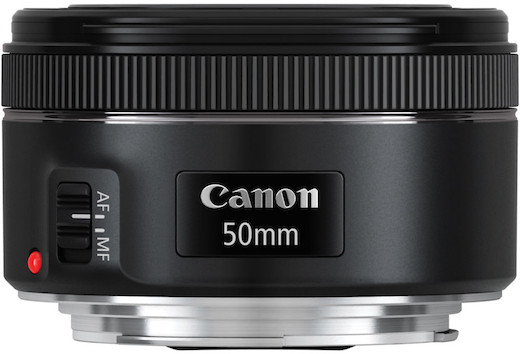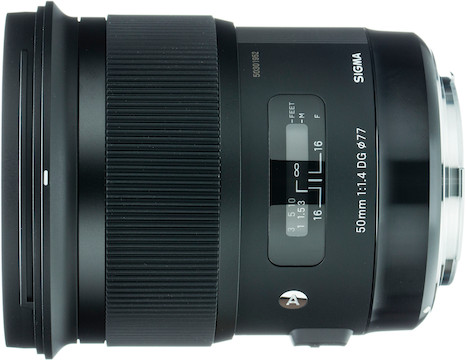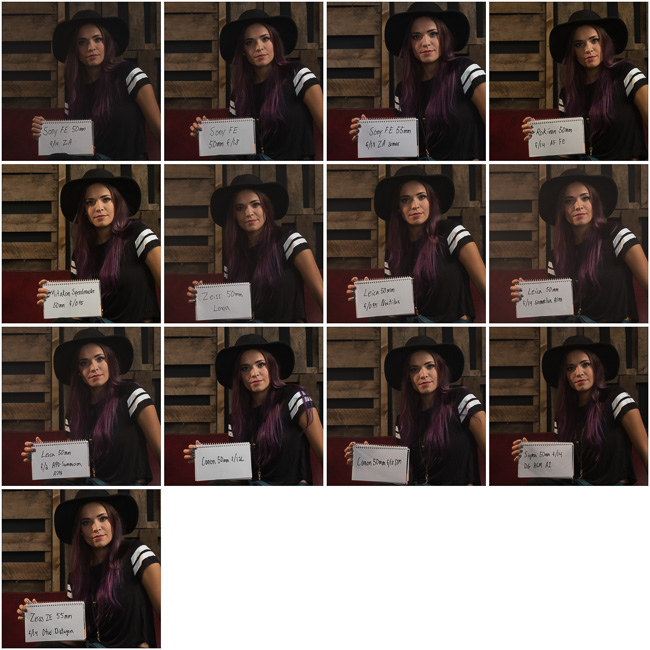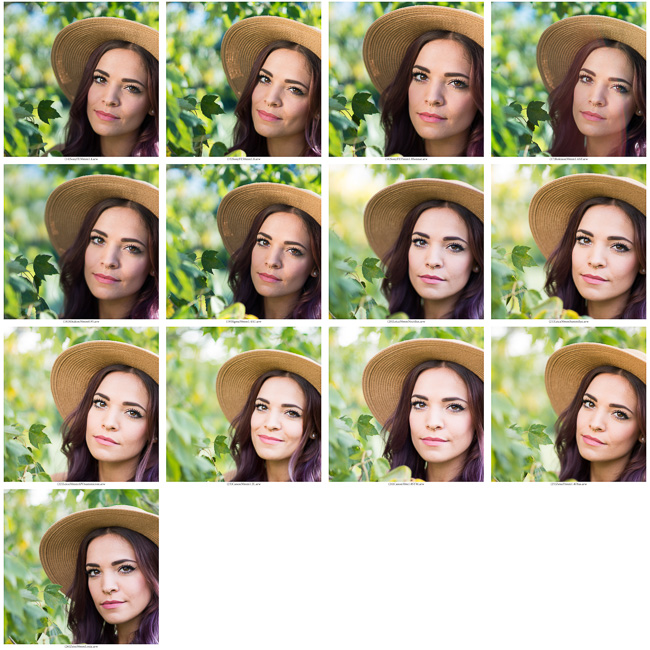Equipment
The Ultimate 50mm Lens Comparison

I want to share with you guys a personal lens purchasing journey that I’ve been on for awhile now. My favorite genre of photography is travel photography; I love capturing landscapes, on location portraits, action sports, and general tourist stuff. It’s a very broad topic, and I want my camera gear to be as versatile as possible. When I travel, I like to be as light and compact as I can get. All my clothes, other personal items, and photography gear needs to fit into one carry-on size backpack. For those reasons my current camera platform of choice is the Sony Alpha series of E-mount cameras. Specifically the Sony A7rII, the A7sII, and the Sony A6300. I find these cameras are capable of capturing fantastic images while at the same time allowing me a much smaller footprint then gear I’ve carried in the past (cough* Canon 1D Mark IV * cough).
In addition to three cameras, I’ve discovered that I don’t want to carry more than four lenses with me at any given time. A wide angle zoom (currently the Sony 16-35mm f/4), a telephoto zoom (the Sony 70-200mm f/4), and two fast primes. The Zeiss Batis 85mm f/1.8 is one of those primes, but I am on a mission to find the best 50mm prime lens for my needs. This is no small task, but I’m determined to do just that.
More than a year ago I pre-ordered a copy of the Mitakon Speedmaster 50mm f/0.95, made by a company called Zhongyi, which I had never heard of before. On paper, this lens was exciting- a heavy duty, native E-mount lens with an exceptional maximum aperture. I was hoping this was going to be the poor man’s Leica Noctilux but in retrospect, I think I let my excitement get the better of me. It was a fun lens to shoot with at first, but over time I came to realize that there was something about the final images that I wasn’t in love with. On a recent trip out of the country, in a dark, rainy environment, I was photographing a family member, taking advantage of the Mitakon’s ability, with its large f-stop, to shoot in low light conditions. On the back of the camera, the images looked satisfactory, but when we went back indoors and loaded the photos on the computer, I was not pleased with what I saw. I realized I had passed the point of no return and it was time to discover if there was a better 50mm option out there for me.
Enter Lensrentals
It turned out that we rent a lot of other options in the “50mm lens that I can mount to a sony camera” category; roughly twenty-four, to be more accurate. As a Lensrentals employee, I already had a good bit of experience with many of these lenses but I had never taken the opportunity to examine them side by side, comparing their strengths and weaknesses, exploring their image quality, and ultimately try to figure out which lens best suited my needs Well, there’s no time like the present, right? We have to do what we have to do, so it’s officially time for a shootout.
I chose 13 of the best 50mm lens options that we carry for the Sony E-mount cameras. I chose the E-Mount, for a number of reasons. First, it’s highly adaptable. Sony has done an incredible job over the last couple years to tap into the market, but their lens lineups still have some catching up to do. Using the E-Mount allows me to not only test Sony and Zeiss lenses, but Sigma and Canon lenses as well. Second, Sony has been my go-to camera for a number of years now. With the small size of the Sony a7r II, I’m able to travel easier and still get great images. Also, however, Nikon lenses were not included in this comparison. That is simply because we can only present so much information in a single post, and we simply did not have time to also test a plethora of Nikon lenses along with the mix. However, we do have extensive information on Nikon lenses if you use the search above.
Now, before we get started, I’ll let it be known that this might not be as scientific as an article from Roger or anyone else who posts to this blog. This article, is real life examples as to how well each 50mm performs. I only used one copy of each lens, I only took a few photos with each setup, and my testing environments were less than lab quality. The reason I went this route is because the 13 lenses that I chose have more differences among them than they have similarities. Yes, they are all prime lenses with a roughly 50mm focal length and yes, I can mount them to an E-mount camera (albeit, some require an adaptor), but other than that they have very little in common with each other. The specs are all over the board. Different weights, sizes, filter threads, optics quality, brand, maximum aperture, focus abilities, and not to mention, price. There’s a huge difference in the costs between the most expensive and least expensive lenses in this group. Coming up with a fair way to judge which lens is actually “the best” would have been an impossible task from the start. So instead I chose to look at these lenses from the point of view of which is the right one for me and that means incorporating my opinion and shooting ability into the mix. So take anything you read here with a grain of salt, as it’s just one photographer’s viewpoint with emphasis on the qualities that are important to them.
Without further adieu, here’s the lineup and I’m going to skip ahead and mention the top pros and cons that I discovered while shooting these lenses. Keep in mind that my primary end goal is a lens for travel photography.
Sony Planar T* FE 50mm f/1.4 ZA
Pros & Cons
| Pros | Cons |
|---|---|
| High-quality lens with a good professional design. | I didn’t feel like it matched well with its price point. It produced a good image, just not a great one. |
Lens Specs
| Focal Length | 50mm |
| Aperture | Maximum: f/1.4 Minimum: f/16 |
| Camera Mount Type | Sony E (Full-Frame) |
| Format Compatibility | 35mm Film / Full-Frame Digital Sensor |
| Angle of View | 47° |
| Minimum Focus Distance | 17.72″ (45 cm) |
| Magnification | 0.15x |
| Maximum Reproduction Ratio | 1:6.67 |
| Elements/Groups | 12/9 |
| Diaphragm Blades | 11, Rounded |
| Features | |
|---|---|
| Image Stabilization | No |
| Autofocus | Yes |
| Physical | |
|---|---|
| Filter Thread | Front: 72 mm |
| Dimensions (DxL) | Approx. 3.29 x 4.25″ (83.5 x 108 mm) |
| Weight | 27.44 oz (778 g) |
MTF Charts

OlafOpticalTesting, 2016
Sony FE 50mm f/1.8
Pros & Cons
| Pros | Cons |
|---|---|
| Very Impressive for a $200 lens | Build quality wouldn’t give me too much confidence when traveling – it feels delicate. |
Lens Specs
| Features | |
|---|---|
| Autofocus | Yes |
| Physical | |
|---|---|
| Filter Thread | Front: 49 mm |
| Dimensions (DxL) | Approx. 2.70 x 2.34″ (68.6 x 59.5 mm) |
| Weight | 6.56 oz (186 g) |
| Packaging Info | |
|---|---|
| Package Weight | 0.7 lb |
| Box Dimensions (LxWxH) | 4.7 x 4.1 x 3.2″ |
MTF Charts
Not Found
Sony Sonnar T* FE 55mm f/1.8 ZA
Pros & Cons
| Pros | Cons |
|---|---|
| Compact, great IQ, fast AF, and the price is reasonably in the middle of the road | Filter size. 49mm means that I would have trouble sharing neutral density and polarizing filters with the other lenses in my kit. It’s not an insurmountable problem, more of an inconvenience. Also, in the studio tests, there seemed to be some small color shifts that would need to be addressed. |
Lens Specs
| Features | |
|---|---|
| Autofocus | Yes |
| Physical | |
|---|---|
| Filter Thread | Front: 49 mm |
| Dimensions (DxL) | Approx. 2.54 x 2.78″ (64.4 x 70.5 mm) |
| Weight | 9.9 oz (281 g) |
MTF Charts
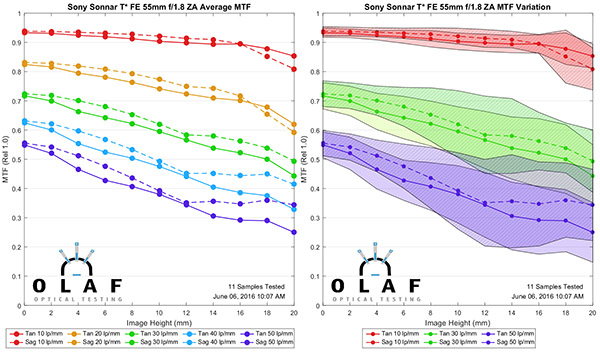
Rokinon AF 50mm f/1.4 FE
Pros & Cons
| Pros | Cons |
|---|---|
| $700 is a pretty good price for a f/1.4 lens with autofocus. | Everything else. Seriously, I tried to give this lens the benefit of the doubt considering it was a new design that I wasn’t very familiar with but it fails in every category that’s important to me. It flared easily, had horrible colors, and even though I wasn’t purposefully testing autofocus, I did notice that its abilities were far from great. |
Lens Specs
| Features | |
|---|---|
| Autofocus | Yes |
| Physical | |
|---|---|
| Filter Thread | Front: 67 mm |
| Dimensions (DxL) | Approx. 2.89 x 3.85″ (73.5 x 97.7 mm) |
| Weight | 1.29 lb (585 g) |
MTF Charts
Not Found
Zeiss Loxia 50mm f/2 Planar
Pros & Cons
| Pros | Cons |
|---|---|
| Extremely compact, World renowned Zeiss image quality, and confidence inspiring weather sealing. | At f/2 it was one of the slowest lenses in the group, and there are other lenses in the same price range that offer a few more features. It’s a great little lens, but it’s not the only fish in the sea. |
Lens Specs
| Features | |
|---|---|
| Image Stabilization | No |
| Autofocus | No |
| Physical | |
|---|---|
| Filter Thread | Front:52 mm x 0.75 mm Pitch |
| Dimensions (DxL) | Approx. 2.44 x 2.33″ (62.1 x 59.2 mm) |
| Weight | 11.29 oz (320 g) |
MTF Charts
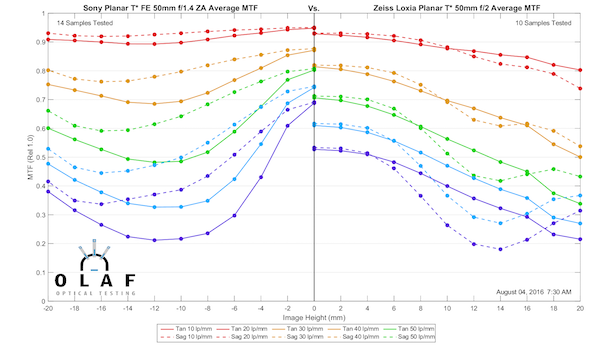
Mitakon Zhongyi Speedmaster 50mm f/0.95
Pros & Cons
| Pros | Cons |
|---|---|
| On paper, the specs are impressive for this price point. It’s a lot of fun being able to shoot at f/0.95. The aperture allows you to shoot in the dark. | My personal copy of this lens seems to have declined in quality since I’ve owned it. It’s constantly a struggle to nail focus which leads me to believe that there’s a slightly decentered element or something else that needs to be repaired. |
Lens Specs
| Features | |
|---|---|
| Image Stabilization | No |
| Autofocus | No |
| Physical | |
|---|---|
| Filter Thread | Front: 67 mm |
| Dimensions (DxL) | Approx. 2.70 x 3.43″ (68.5 x 87 mm) |
| Weight | 1.58 lb (720 g) |
MTF Charts
Not Found
Leica Noctilux-M 50mm f/0.95 ASPH
Pros & Cons
| Pros | Cons |
|---|---|
| Almost everything about this lens is awesome, and it has so much heritage that it’s exciting just to hold it. | The price is really steep, and the images have more chromatic aberration (i.e. purple fringe) then a lens in this price range should have, but I don’t think that’s anything new for anyone who has ever shot with this lens. The minimum focusing distance of 1 meter is limiting. |
Lens Specs
| Features | |
|---|---|
| Image Stabilization | No |
| Autofocus | No |
| Coding System | 6-bit |
| Physical | |
|---|---|
| Filter Thread | 60 mm |
| Dimensions (Diam. x L) | 2.9 x 3.0″ (73.0 x 75.1 mm) |
| Weight | 1.5 lb (700 g) |
MTF Charts
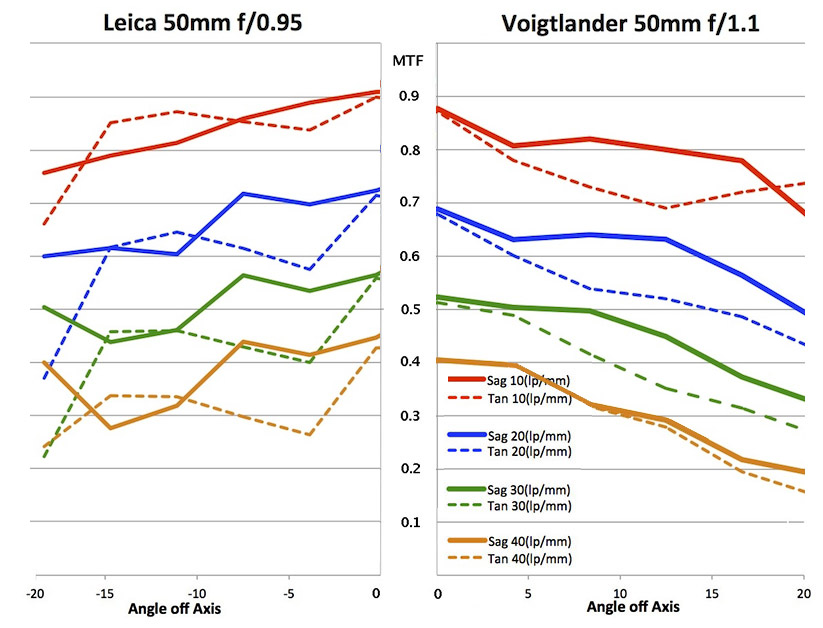
Leica Normal 50mm f/1.4 Summilux M
Pros & Cons
| Pros | Cons |
|---|---|
| Super compact and it’s everything you’d expect from a Leica lens. | While the images were great I don’t think they were so far above the rest of the lens offering in this list that it justifies the price difference. This lens doesn’t make me want to buy it; it makes me want to rent it, along with a Leica camera body, and get the whole rangefinder experience. For me, kind of a “go big or go home” situation. |
Lens Specs
| Performance | |
|---|---|
| Focal Length | 50mm |
| Aperture | Maximum: f/1.4 |
| Camera Mount Type | Leica L |
| Format Compatibility | 35mm Film / Full-Frame Digital Sensor |
| Elements/Groups | 11/9 |
| Features | |
|---|---|
| Image Stabilization | No |
| Autofocus | Yes |
| Tripod Collar | None |
| Physical | |
|---|---|
| Filter Thread | Not Specified By Manufacturer |
| Dimensions (DxL) | Not Specified By Manufacturer |
| Weight | Not Specified By Manufacturer |
MTF Charts
Not Found
Leica APO-Summicron-M 50mm f/2 ASPH
Pros & Cons
| Pros | Cons |
|---|---|
| Phenomenal image quality, super sharp, beautiful skin tones. It’s the only lens in this group that makes me have irrational internal monologues like “who cares that it’s got a 39mm filter thread, using any filter or other glass in front of this thing is insulting.” Or “the price isn’t that bad. It would pay for itself in just a few years.” | The price. That’s it. |
Lens Specs
| Focal Length | 50mm |
| Aperture | f/2 to f/16 |
| Camera Mount Type | Leica M |
| Angle of View | 47° |
| Smallest Object Field | 10.7 x 16.0″ / 271 x 407 mm |
| Entrance Pupil | 0.96″ / 24.4 mm (position from bayonet flange) |
| Minimum Focus Distance | 2.3′ / 70 cm |
| Reproduction Ratio | 1:11.3 |
| Optical Design | 8 elements in 5 groups |
| Diaphragm Blades | Not specified by manufacturer |
| Focus | Manual |
| Filter Thread | 39 mm |
| Dimensions | 1.9 x 2.1″ / 47 x 53 mm |
| Weight | 10.6 oz / 300 g |
MTF Charts
Not Found
Canon EF 50mm f/1.2L
Pros & Cons
| Pros | Cons |
|---|---|
| Not just from these shoots, but I know this is a workhorse lens that’s very reliable. If I were moving from a Canon system and already owned this lens, I wouldn’t hesitate to use an adapter and keep this lens around. | With an adapter it’s bulky and clumsy plus it’s an older model lens that may get an upgrade soon so it wouldn’t be a sound investment considering I don’t already own it. |
Lens Specs
| Features | |
|---|---|
| Image Stabilization | No |
| Autofocus | Yes |
| Tripod Collar | No |
| Physical | |
|---|---|
| Filter Thread | Front: 72 mm |
| Dimensions (DxL) | Approx. 3.38 x 2.58″ (85.8 x 65.5 mm) |
| Weight | 1.30 lb (590 g) |
MTF Charts
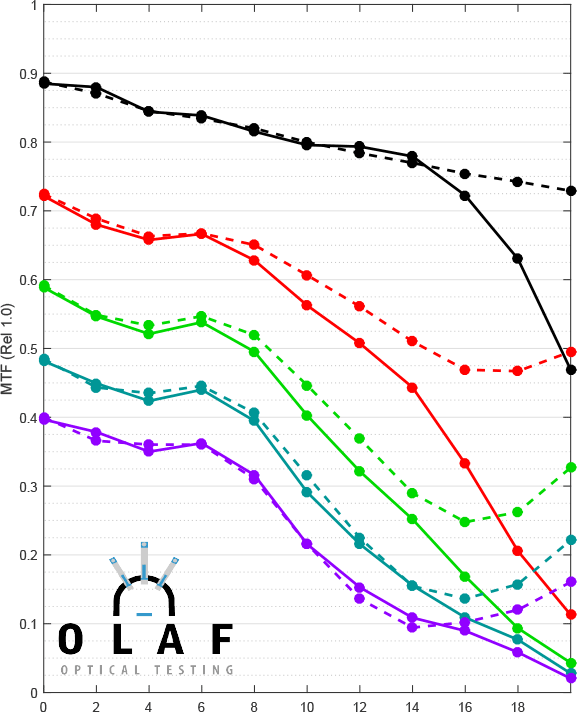
Canon EF 50mm f/1.8 STM
Pros & Cons
| Pros | Cons |
|---|---|
| I was crazy impressed with the images coming from this $125 little lens. Any Canon shooter should have this lens around just because of the value it provides. | It has a plastic body, and an adapter to use this on a Sony camera is probably going to run 2-3x the cost of the lens itself. |
Lens Specs
| Features | |
|---|---|
| Autofocus | Yes |
| Physical | |
|---|---|
| Filter Thread | Front: 49 mm |
| Dimensions (DxL) | Approx. 2.7 x 1.6″ (68.58 x 40.64 mm) |
| Weight | 5.7 oz (162 g) |
MTF Charts
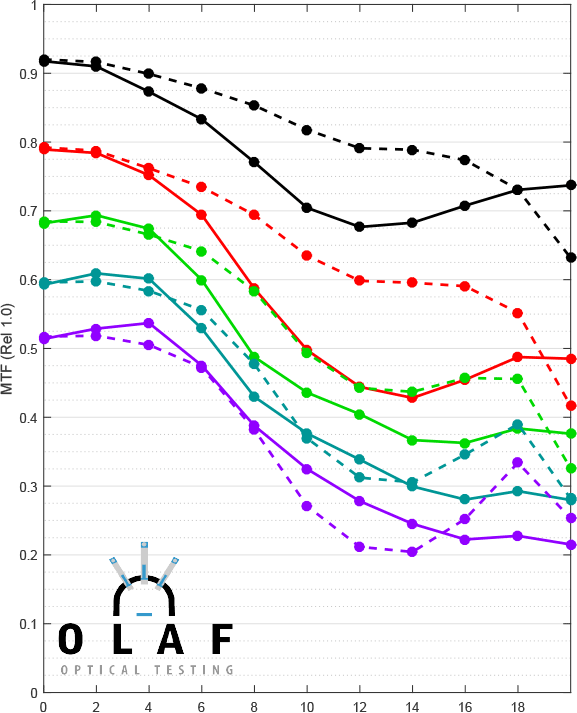
Sigma 50mm f/1.4 DG HSM Art
Pros & Cons
| Pros | Cons |
|---|---|
| Definitely one of the sharpest lenses in this test and very low distortion for a lens at that this price point. Distortion is not usually the first thing I notice when looking at studio images but in this case the lack of is noticeable. | You have to use an adapter. It would be so exciting if Sigma could make this lens in a native E-mount without losing any quality. |
Lens Specs
| Features | |
|---|---|
| Autofocus | Yes |
| Physical | |
|---|---|
| Filter Thread | Front:77 mm |
| Dimensions (DxL) | Approx. 3.36 x 3.93″ (85.4 x 99.9 mm) |
| Weight | 1.79 lb (815 g) |
| Packaging Info | |
|---|---|
| Package Weight | 2.6 lb |
| Box Dimensions (LxWxH) | 7.1 x 4.8 x 4.7″ |
MTF Charts
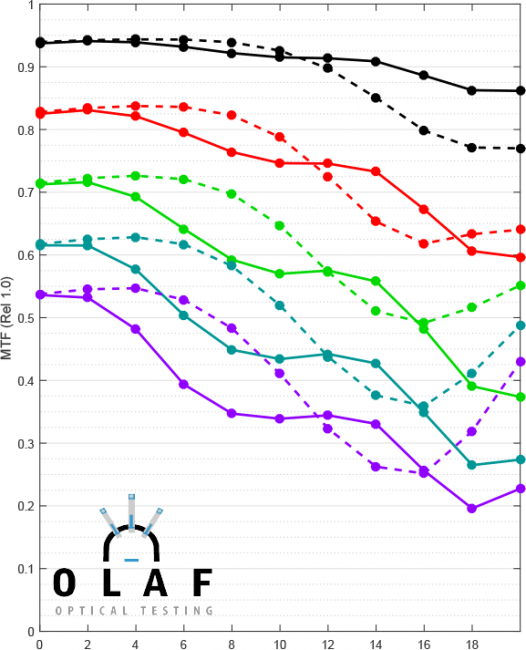
Zeiss 55mm f/1.4 Otus Distagon
Pros & Cons
| Pros | Cons |
|---|---|
| In my opinion, it produced the best images from the entire shootout. All of the “high resolving power” you hear about with this lens is not marketing hype. You can see it in the photos. | Size and weight. This thing is huge and in reality it was never a contender for me as a lens for travel photography. |
Lens Specs
| Features | |
|---|---|
| Image Stabilization | None |
| Autofocus | None |
| Tripod Collar | No |
| Environmental | |
|---|---|
| Operating/Storage Temperature | Not Specified By Manufacturer |
| Physical | |
|---|---|
| Filter Thread | 77 mm |
| Dimensions (DxL) | Approx. 3.64 x 5.66″ (9.25 x 14.38 cm) |
| Weight | 2.27 lb (1030 g) |
MTF Charts
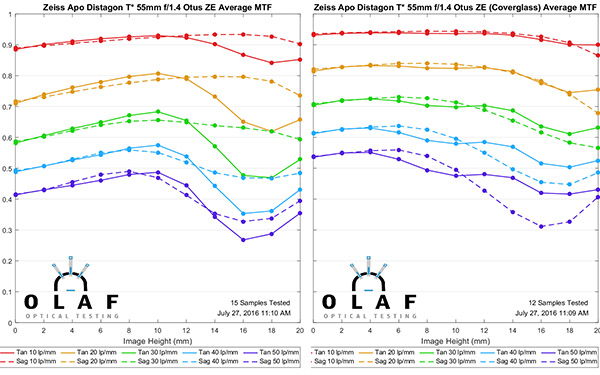
OlafOpticalTesting, 2016
I wanted to test these lenses in a way that made sense to me and see what I could discover from shooting with them that I couldn’t tell by just looking at the specs for each lens. I may have heard a rumor that one lens vignettes a lot, but what does “a lot” look like exactly? Or, “Lens A is more expensive, but it’s sharper than Lens B.” Ok, how much difference am I going to notice, what’s my acceptable level of sharpness, and how much am I willing to spend to get it? The best way for me to answer these questions for myself is to create some real world shooting scenarios where I can use all of the lenses in the same manner, in the same place, on the same subject and then look at the results.
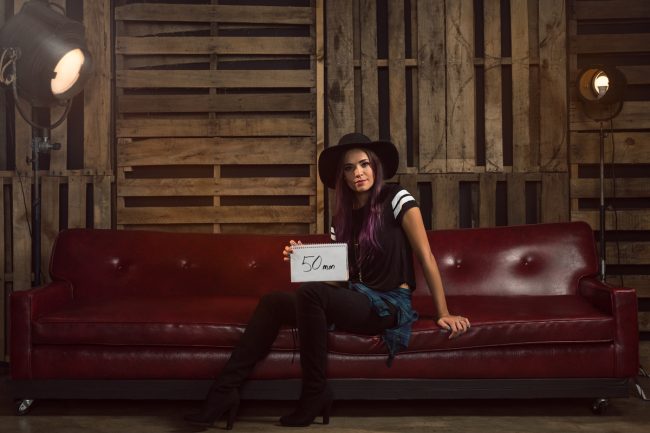
So for the first test shoot, I went into the studio, fired up the strobe lights, got a model, filled the room with haze, and proceeded to set up a quick scene that I could photograph with all 13 lenses. I chose the camera settings ahead of time. Manual exposure, ISO 100, 1/125th of a second shutter speed, and an aperture of f/8. Now, a f/8 aperture should be near, or at, the “sweet spot” for each of these lenses. They should all be at their best level of performance regarding image quality, including sharpness, resolving power, color, and hopefully, a lack of any aberrations. When comparing so many different lenses, this is about as even of a playing field as it gets.
After framing the shot, I locked the camera off on a tripod and began shooting each lens 4 or 5 times, making sure to reset and manually focus between each shot. Lather, rinse and repeat. During this process, we attempted to keep an even level of haze in the room and our model, Stephanie, sought to keep the same pose throughout all of the shots. Like I said before, it may not be as scientific as an MTF chart, but neither is shooting.
Back in the office, I loaded the images on the computer and culled through all of the shots, selecting the best example from each lens. I want to make these 13 raw files available for anyone that wants to download them and make their own comparisons because I know I’m not the only one that likes to pixel peep every once in awhile.
Download Studio Test Shoot Raw Files
Here’s a full summary of what I saw after spending time zooming around each image, playing with lens profiles, and comparing various cropped portions of the photos: When just considering image quality, there’s not always a direct relationship between quality and price. The best example of this can be seen when comparing the Sony FE 50mm f/1.4 and the Sony FE 50mm f/1.8. The former is more than 7 times the cost of the Sony’s entry level prime. It’s IQ is virtually the same, it’s certainly not 7x better. That means the $1300 dollar price difference between the two is going towards something else, supposedly build quality, or maybe a better focus motor.
I discovered that my bias against Rokinon is justified and I don’t have to feel like a snob for not wanting to use it. While the Mitakon and Noctilux share a few similar traits, mainly their f/0.95 apertures, my copy of the Mitakon can’t hold a candle to anything with the name Leica on it. Even at f/8, it has terrible field curvature. The price tag associated with the APO-Summicron is about more than just sharpness. It has probably the best color tones of any lens that I have ever shot. I would not have been able to guess the price point of the Canon EF 50mm f/1.8 by just looking at the photo. Canon’s Nifty-Fifty is better than Sony’s and the Zeiss Otus produced the best overall image from all 13 lenses.
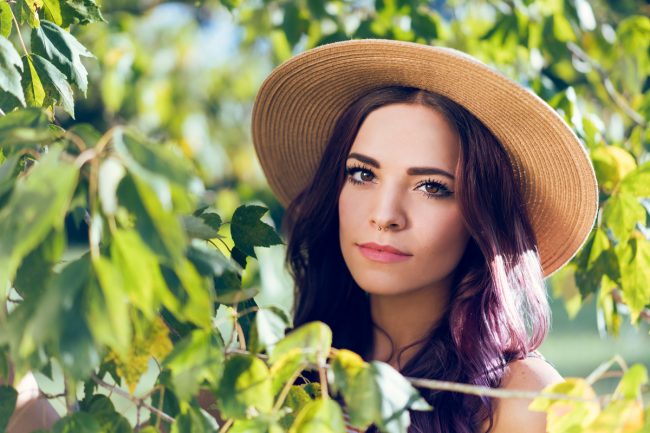
The second test shoot was designed to show how the lenses performed at their maximum aperture. This is more about the lens’s raw ability. Wide open, their strengths and weakness should become more apparent. Even if you don’t often shoot wide open or have the need for low light performance, the aperture number on the side of the lens is often a big part of what you’re paying for so it’s nice to know what you’ll get if you ever need to go there.
Just like in the studio, I created a scene that I thought would showcase several aspects of all of the lenses. We took our model outside and stuck her in between some low hanging branches from a tree down the street from our office. We framed the shot at a slight angle giving us elements in the foreground and the background so we’d see more differences in the depths of field these lenses created. This time, I shot in aperture priority mode and let the camera make the exposure decisions because there was a variety of different maximum apertures in our test group. Just like before though, we fired off 4-5 shots with each lens, making sure to reset and manually focus between each shot. Afterward, on the computer, I again culled through all of the images, selecting the best example from each lens.
Now for this test, I was using just natural light. The setting sun was behind the model, off-camera right, and I was using a Sunbounce reflector, camera left, to bounce fill light back into her face. Everything was going well until we got through all of the native e-mount lenses and were about to move onto the EF and M mount lens. I reached into my camera bag and realized that I had left the lens adapters back in the office. I ran back inside and got them but in the short time it took me to do that, the sun dipped just below the treeline and our lighting conditions changed drastically. If you download the raw files from this shoot, you’ll see what I mean.
At this point, I had a couple of options. Re-shoot all of the lenses in the new lighting conditions, chase the setting sun around, or reschedule the shoot. I did none of those things and here’s why: I decided at that time that I didn’t want to have to rely on an adapter in this lens decision. It’s one more piece of gear to keep up with, it’s another potential point of failure, and it’s more bulk. If I had an investment already in lenses from another camera platform, it might make more sense to use an adapter and continue to rely on the glass that I already had. In my case, I don’t need to do that as I’m building my lens kit from scratch.
Side note: In order to be as unbiased as possible when comparing this round of images, it’s helpful to try and remove any strong distractions such as the huge color and contrast differences between the two lighting scenarios. I chose to use some automated features in Adobe Lightroom to make this process easier. I went through each image and using the custom white balance tool selected the sclera, or white part, of Stephanie’s right eye. I then selected the entire group of photos and used the “Auto Tone” feature of Lightroom.
To summarize these natural light test shots, you tend to get what you pay for in terms of sharpness which the exception being the Zeiss Otus as the clear winner, even though it’s actually not the most expensive lens in the group. Most other aspects remained the same as they were in the studio shoot. The Mitakon continued to yield bad colors as did the Rokinon which also proved to be the least sharp and exhibited horrible flaring even though we were not directly shooting into the sun. Also worth noting, the more expensive lenses nailed the focus point (the model’s left eye) much more consistently. I used the focus peaking in addition to the focus assist (zoom) features of the Sony A7rII but still struggled with the less expensive lenses. The only other real revelation was the tough reminder that the Leica Noctilux has a close focus distance of 1 meter, which happened to be exactly the distance that I was shooting at. Depth of field is related to focus distance, that means that even though the Leica has a f/0.95 aperture, lenses like the Canon EF 50mm f/1.2 are capable of achieving a more shallow depth of field image just because it can shoot closer to the subject.
Natural Light Test Shoot Raw Files
So with the test results in mind, it’s time to look back at some of the specifications of each lens that I consider to be important.
| Lens | 3-Day Rental Price | Purchase Price | Filter Size | Weight (in grams) | Max, Aperture | Min. Focus Distance (in cm) |
|---|---|---|---|---|---|---|
| Sony Planar T* FE 50mm f/1.4 ZA | $59 | $1498 | 72mm | 778 | 1.4 | 45 |
| Sony FE 50m f/1.8 | $15 | $198 | 49mm | 186 | 1.8 | 45 |
| Sony Sonnar T* FE 55mm f/1.8 ZA | $47 | $898 | 49mm | 281 | 1.8 | 50 |
| Rokinon AF 50mm f/1.4 | $40 | $699 | 67mm | 585 | 1.4 | 45 |
| Zeiss Loxia 50mm f/2 Planar | $35 | $949 | 52mm | 320 | 2 | 45 |
| Mitakon Zhongyi Speedmaster 50mm f/0.95 | $47 | $849 | 67mm | 720 | 0.95 | 50 |
| Leica Noctilux-M 50mm f/0.95 ASPH * | $343 | $10650 | 60mm | 700 | 0.95 | 100 |
| Leica Normal 50mm f/1.4 Summilux m * | $134 | $3795 | 46mm | 335 | 1.4 | 70 |
| Leica APO-Summicron-M 50mm f/2 ASPH * | $240 | $7795 | 37mm | 300 | 2 | 70 |
| Canon EF 50mm f/1.2L ** | $41 | $1349 | 72mm | 590 | 1.2 | 45 |
| Canon EF 50mm f/1.8 STM ** | $11 | $125 | 49mm | 162 | 1.8 | 35 |
| Sigma 50mm f/1.4 DG HSM Art ** | $45 | $949 | 77mm | 815 | 1.4 | 40 |
| Zeiss 55mm f/1.4 Otus Distagon ** | $118 | $3990 | 77mm | 1030 | 1.4 | 50 |
** requires use of a Canon EF lens to Sony E camera adapter
Personal Summary
My purpose for doing these shoots was to find a 50mm prime lens, well suited for travel photography, to replace my quickly aging Mitakon Speedmaster. For me, the compact nature of both the Sony FE 55mm f/1.8 and the Zeiss Loxia 50mm f/2 Planar, combined with average price points but above average image quality means these are the two lenses I’m considering. Although the Loxia has a slight advantage over the Sony regarding image quality, I need to decide whether or not I’m willing to sacrifice that to gain great autofocus. I have a couple of trips coming up, including the Photo Plus Expo in New York, so I’m going to spend some more time renting and using both of these lenses before I decide which one finds a permanent home in my bag.
If you guys have any questions, comments, or arguments, leave them below.
Author: Chase Reynolds
-
Ed Bambrick
-
Mark
-
Scott Oblander
-
Y.A.
-
Charlie
-
Will
-
Park J.S.
-
banpreso
-
L.E. Miller
-
Not An
-
denneboom
-
Joe Fitzpatrick
-
David Alexander
-
Trip35
-
Shaun O’Boyle
-
jp
-
flbrit
-
Chase
-
Chase
-
Athanasius Kirchner
-
HF
-
Chase
-
Chase
-
Chase
-
Chase
-
joel richards
-
HF
-
Ron H
-
Trip35
-
obican










